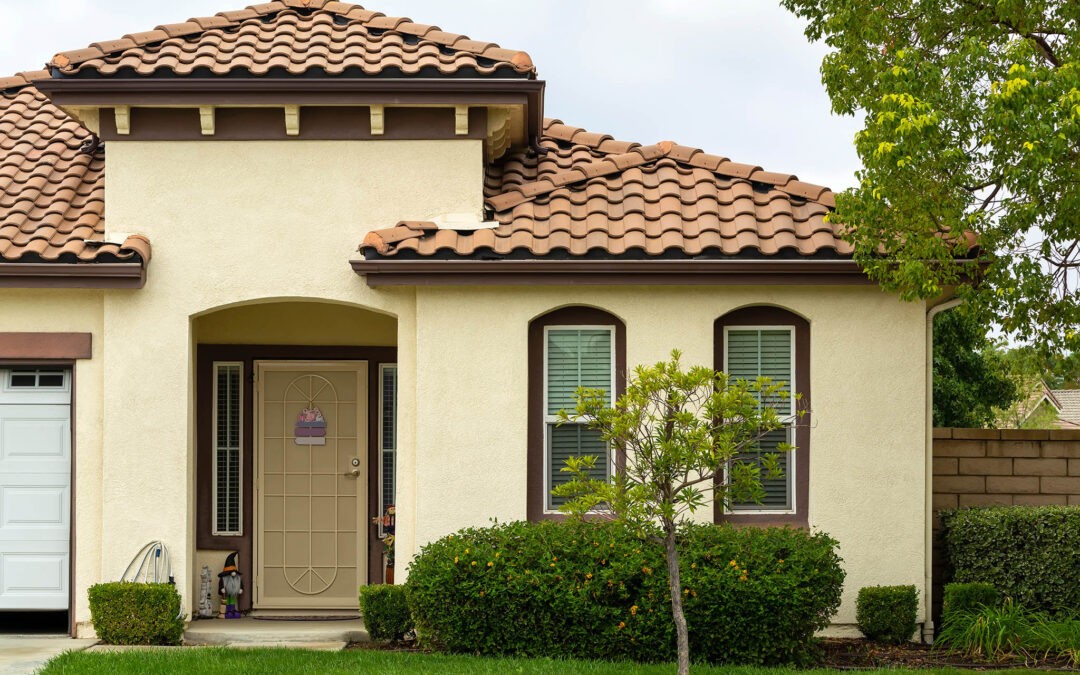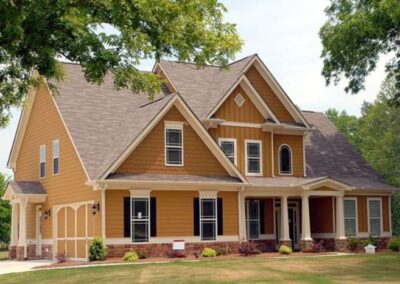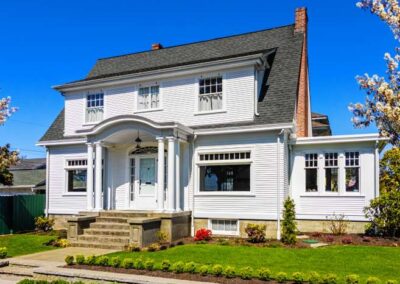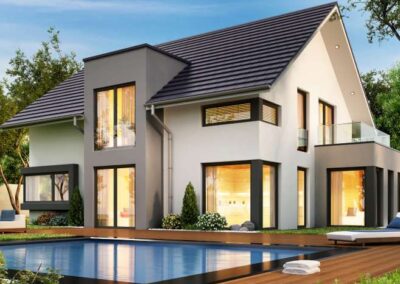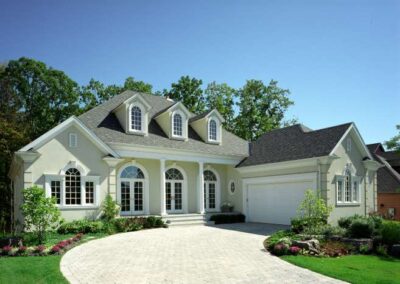Florida’s beautiful weather and lush greenery create a vibrant backdrop that makes color selection important. Choosing the right exterior color scheme in Florida can transform your home’s appearance. A cream-colored house stands out in a neighborhood for its warm, inviting presence and elegance. It can convey a sense of calm and understated sophistication.
How Cream House Exterior Color Schemes Complement Florida’s Natural Landscape
This timeless appeal becomes even more powerful when paired with Florida’s natural surroundings. Cream exteriors present an elegant look that feels natural and refined. This color choice appeals to homeowners who want their property to reflect charm and good taste without appearing overly bold.
Cream is a soft hue that sits between white and yellow on the color spectrum. The neutral quality of cream allows for creative freedom when selecting trim, fixtures, and landscaping elements.
You can use it as a flexible foundation and add your personal touch through paint, wood, brick, or metal accents. Cream works beautifully with a variety of architectural styles, whether you’re drawn to a contemporary coastal design or the charm of a Key West Conch home.
Color Combinations That Work Well with Cream Exteriors
Pairing cream with the right accent colors can elevate your home’s exterior design and add property value. House painters in Miami share a few popular combinations that go well with cream exteriors:
- Classic White Trim: Use bright white paint for window frames, cornices, and eaves to emphasize architectural lines.
- Warm Wood: Add a natural wood pergola or porch ceiling. You may opt for wood-look garage doors for a textured, craftsman-inspired style.
- Soft Grays: You can modernize a cream exterior by using light gray for small features like trim, doors, or shutters.
- Muted Greens: Olive or sage green accents work especially well on shutters, doors, or planters when paired with a cream exterior. These shades complement garden landscaping and tree-lined properties.
Incorporating Textures and Materials
Wood
Adding texture and materials to your cream-colored exterior can make your home full of character. Natural wood is a great place to start.
You can incorporate wood in ceiling soffits, pergolas, porch railings, garage doors, or even as siding accents to break up larger wall surfaces.
These features create subtle focal points that draw the eye and make the home feel more welcoming. They’re also easy to update, which gives you flexibility in updating your exterior without major renovations. On a cream-colored home, these natural wood accents add just enough contrast to stand out while still blending with the soft, neutral palette.
Brick & Stone
If you’re designing a cream-colored home in Florida and want to add a sense of structure and timeless charm, brick and stone are excellent material choices. Brick in warm, sun-washed tones, like soft terracotta or light brown, can be used to frame the entryway, outline windows, or accent the lower half of the façade.
If you’re going for a coastal or natural look, stone is a great choice. Materials like coral stone, shellstone, or light limestone work especially well with cream exteriors. You can add stones on porch columns, along base walls, or in walkways to add texture and depth. The mix of cream and light stone creates a look that feels solid but still relaxed, which fits perfectly with Florida’s tropical vibe.
Metal
Metal accents are an easy way to add a bit of contrast and polish to a cream-colored home without overpowering its soft look.
Bronze light fixtures by the front door or garage can catch the sunlight in a striking way. Gutter systems in a matte bronze finish offer a clean, finished look that blends well with cream tones.
These touches may seem minor, but they make a difference in giving your home a more refined and intentional feel.
Tips for Choosing the Right Cream Shade
The undertone of your cream shade can influence how your home feels overall—whether you’re aiming for warmth, elegance, or balance. Below is a quick guide to help you choose the right tone based on the mood and style you want to create.
| Tones | Description |
| Warm Cream Shades | Yellow, peach, or beige undertones. Create a welcoming feel that works with traditional architecture. |
| Cool Cream Shades | Lean toward soft grays or off-whites. Ideal if you’re going for a minimalist or coastal look and pair nicely with metal accents and sleek architectural lines. |
| Neutral Cream Shades | A safe choice if you want your home to feel classic without leaning too far in either direction. Neutral creams adapt well to different styles and allow more flexibility with accent colors. |
| Buttermilk Shades | Buttermilk or light camel tones bring depth to your exterior. Pair best with dark wood, brick, or bronze accents. |
Maintaining Your Cream Exterior
Wash the exterior every few months using a soft-bristle brush or a low-pressure washer with a mild detergent. Focus on shaded areas where mildew or algae might form, especially in humid Florida climates.
For stains caused by rust, pollen, or bird droppings, use a gentle all-purpose cleaner or a vinegar-water mix with a sponge. Avoid abrasive scrubbing tools that can damage paint.
Look for insect nests, cobwebs, or wasp hives in porch corners and under eaves. Use a broom or long-handled duster to keep these areas clean and discourage nesting.
Apply a clear UV-resistant sealant every 3–5 years to protect against sun fading, moisture buildup, and salt air damage, especially important for coastal Florida homes.
Trim back bushes, vines, or trees that brush against the house. Overgrown greenery can lead to mildew, stains, or even paint damage from constant contact.
Conclusion
Choosing a cream exterior color scheme offers a blend of timeless elegance and versatility. By pairing cream with complementary colors, incorporating various materials, and selecting the right shade, you can create a stunning exterior that reflects your personal style and enhances your home’s curb appeal. Whether you’re in Melbourne, Port St Lucie, Gainesville, or Kissimmee, embracing a cream color scheme can transform your home’s appearance, making it a standout in any neighborhood.
Ready to bring your vision to life? Get a free quote and discover how professional painters in your area can help you achieve the perfect look for your home.
Frequently Asked Questions
How many colors should a house exterior have?
Many home designers recommend using three colors for your home’s exterior. A common guideline is to use one main color for the body of the house, one trim color for window frames, eaves, and moldings, and one accent color for the front door, shutters, or other focal points.
How to select exterior house paint colors?
Start by considering your home’s architecture and the light conditions. Look at materials like the roof, stone, brick, or driveway. These won’t change and should guide your color palette.
In sunny states like Florida, lighter shades like cream, beige, or light gray perform well because they reflect heat and resist fading.
House painters in Miami recommend sticking to warm undertones in cream or beige (such as buttery cream, sand, or light tan) if you’re going for a classic look, or cooler tones (like pale ivory, soft greige, or cream with subtle gray undertones) if you want a modern, coastal vibe.
Always test your top color choices on a small section of the house and observe them at different times of day.
What exterior colors go with a brown roof?
Cream, warm beige, sage green, and muted yellow all pair well with a brown roof. These colors complement the roof’s earthy tone by staying within a similar warm color family, which creates visual harmony and prevents harsh contrast.

